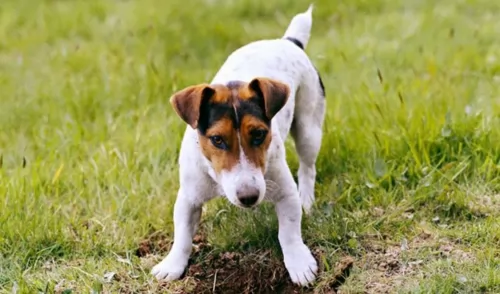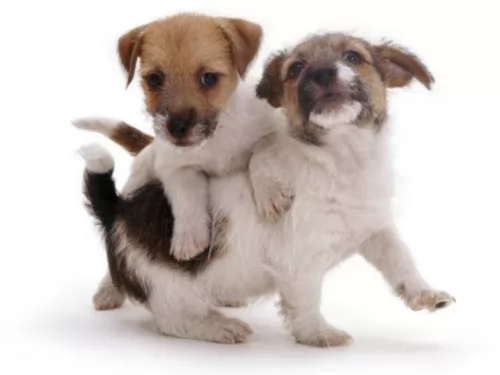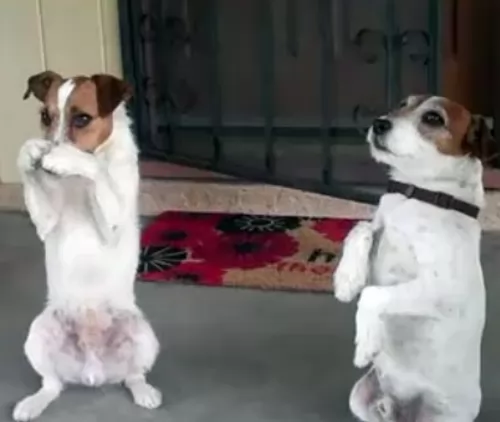 MyDogBreeds
MyDogBreedsRussell Terrier is originated from United Kingdom but Bisben is originated from India. Russell Terrier may grow 41 cm / 16 inches shorter than Bisben. Russell Terrier may weigh 43 kg / 94 pounds lesser than Bisben. Both Russell Terrier and Bisben has almost same life span. Both Russell Terrier and Bisben has almost same litter size. Both Russell Terrier and Bisben requires Low maintenance.
 This feisty little dog was developed in England a couple of centuries ago. He has a well documented history. An interesting aspect with this dog is that the very name ‘Jack Russell’ became a common name for predominantly white terriers after the death of clergyman Jack Russell.
This feisty little dog was developed in England a couple of centuries ago. He has a well documented history. An interesting aspect with this dog is that the very name ‘Jack Russell’ became a common name for predominantly white terriers after the death of clergyman Jack Russell.
The Russell Terrier was developed from Jack Russell working terrier strains that were used in the 19th century for hunting fox. The dog has been standardized by Kennel Club recognition. The Fedédération Cynologique Internationale also recognizes the breed.
It was in the early 1970s that the Jack Russell Terrier Club of Great Britain was formed.
There is a lot of mystery surrounding this large herding dog said to come out of the Himalaya Mountains of Asia. The belief is that sheepdogs were crossed with wolves toward the end of the 18th century, but his origin is basically unknown. They are both herding dogs and guard dogs. Others theorize that rather than a wolf, the breed arose from the Mastif family. Still others claim that the Bisben is not a breed at all but rather a “landrace”. A landrace is an animal group that is only found to exist in the local area or is bred locally for a specific reason, while a breed is developed intentionally and from a select purebred with pedigree. The Bisben may be a landrace since it is very popular in India but hardly known anywhere else. What is known is that the Brisben was in existence at the end of the 1700’s and its job was to protect and herd livestock. There are three main theories about the origin of the Bisben. They are, in no particular order:
1. The Bisben was developed by mixing several different Himalayan and Indian Sheepdogs with wolves. The wolf population in the Himalayas and in India live in very close proximity to dogs and people and this population is quite large. These Tibetan and Indian wolves are known to be smaller, more comfortable with people and less aggressive than wolves from other parts of the world.
2. The Bisben was developed by mixing local sheep herding dogs with the Tibetan Mastiff. This gave the breed its protective nature and its large size according to this theory.
3. The Bisben was developed by mixing local dogs with the ones the British, Portuguese and French imported to the India subcontinent.
There is a fourth theory as well and it combines all three of these, supposing that the Bisben is a product of crossing local dogs with wolves, Tibetan Mastiffs and European dogs.
Regardless of their origins, the Bisben grew into one of the most respected animals in the Southern Himalayas. Their assistance to the shepherds of the area was unquestioned and irreplaceable. They were touch enough to herd flocks of goats or sheep across several treacherous and unstable mountain passes. The environment in which these dogs worked when herding is one of the harshest environments on the face of the earth. Temperatures were dangerously cold, altitudes dangerously high and the terrain just plain dangerous. Many deadly large predators live there as well. This included tigers, Asiatic black bears, golden eagles, Himalayan brown bears, snow leopards, fox, dholes, wolves, and small cats. The Bisben had to be able to fight off all of these predators. In addition to these herding and protecting duties, the Bisben was also known throughout the region as an excellent hunting dog. They are capable to this day of hunting large prey such as antelope or deer. They are equally comfortable hunting alone or in a pack. He has grown into one of the most popular hunting dogs in all of India.
The Himalayas, being so rugged and treacherous, were inaccessible to most of India for many centuries and the Brisben was unknown as well. Through the British imperialist expansion across all of the Indian subcontinent, the lowlands people were connected to the highlands and mountain people for the first time. This also meant that the Brisben was no longer unknown. The entire country began to appreciate the dog for its protection and herding of livestock, as well as a companion animal who would protect its owner and family as well. As India continues to grow the popularity of the Brisben grows as well and its numbers increase regularly. The breed, if it is a breed, remains an Indian secret. They have migrated to the countries around India, but their number are small. It is only in India that they are revered and prosper. They are not present in any great numbers in Europe, North America, Japan, or most of Asia.
Whether or not the Bisben becomes a recognized breed depends upon those who own and fancy them. Most Bisbens are bred to only other Bisbens in an effort to purify the breed. However, few dogs have pedigrees and the practice of breeding the Brisben to other breeds and mixed breed to acquire specific characteristics continues to this day. It is unlikely that the Bisben will ever be a purebred dog. It is quite variable in how it looks depending upon what the breeding line of the individual dog actually is. Does it look like a wolf? Does it look like a larger version of a local or European dog? There will always be these questions around the Bisben. Is it a breed or a landrace?
 The Russell Terrier has a weatherproof coat that is mainly white with patches of tan or black or maybe even both. You get the smooth haired type, the broken type- as well as the rough haired Russell Terrier. All these coats shed.
The Russell Terrier has a weatherproof coat that is mainly white with patches of tan or black or maybe even both. You get the smooth haired type, the broken type- as well as the rough haired Russell Terrier. All these coats shed.
He is a small dog standing at between 20-35cm in height and weighing between 7 and 12kg.
Your Russell Terrier is a jaunty, fearless, confident little dog with a powerful personality. The bright face with alert eyes are constantly telling you that he is just ready to spring into action when you’re ready.
He just loves games and sports and you won’t have to ask him twice to join in. Happy and energetic, you could say it's his desire to hunt as well as his high energy levels that make it necessary for him to be trained and socialized It is of particular importance because he is so strong willed. Super smart, you won't have any trouble teaching him some basic commands.
He also makes a good watch dog and while he can be aggressive towards other dogs, he is prepared to get along with children in the house who have been disciplined and who know how to treat animals with respect and kindness.
As mentioned in the previous section the appearance of the Brisban can vary greatly from one dog to another based on the individual dogs’ ancestry. Breed or landrace, the Brisban breeding line is not very pure. Therefore, appearance can vary greatly from what is described here and there is no standard by which to measure the Brisban. Most are distinctly large animals, being as tall as the European mountain dogs – the Newfoundland or the Bernese Mountain Dog, Swiss Mountain Dog. St. Bernard and Great Pyrenees. Reports are that it is perhaps the largest dog in India. At least it is one of the largest dogs in India. The Bisben is said by some to be a large, bulky, husky dog while others claim it to be tall and athletic, leaner than the Mastiff bred. Again, there is disagreement on the size and shape of the Bisben’s head with some claiming it is massively square like a Mastiff while others say the head is long and like that of a wolf not a Mastiff. The long hair of the Bisben and its confusing heritage may be the cause. They are most often black but might also be found to be tricolor, tan and “wolf-color” or brown, grey, shades of sable and black. No matter how it looks, this is a dog that was designed to work in the harshest conditions known and their physical appearance should make that abundantly clear.
 It is true that this very active, very 'in-your-face' dog may not be everybody’s cup of tea. He will be discontent if not given the chance to run and be active.
It is true that this very active, very 'in-your-face' dog may not be everybody’s cup of tea. He will be discontent if not given the chance to run and be active.
If you’re a super active family who loves swimming, going on hikes or you enjoy sports such as cycling and horse riding, you can count the Russell Terrier in every time.
These dogs make a loving, loyal companion. They'll make you smile and be amused by their antics, bringing you lots of joy and entertainment.
The Bisben was so important to the people of the Indian subcontinent because of her temperament. He is a loyal, productive and courageous worker who took care of her flocks, her family and her pack. They are devoted to their family and if raised with children will care for them as well. He is suspicious of strangers. They are territorial and great watchdogs. They can take on any large challenger if need be to protect what they consider to be theirs. They can be highly dog aggressive and must be socialized as a puppy. Do not mix them with strange, unknown animals as the Bisben might attempt to kill them. If he sees them as his “pack” he will love and protect them, but not if he does not know them. Take as much time as you need to introduce him to a new animal and do not leave them unsupervised. They are not easy to train as they are stubborn, intelligent, want to be dominant and is a problem solver. If he doesn’t want to learn something forget it – he won’t. You can still train them. It just takes time and patience.
 The Russell Terrier is a robust little dog who can lead a good, healthy life of 13, 14 or 15 years if well cared for. There are however, a number of common dog ailments that he can succumb to. Some of these are cataracts, deafness and myasthenia gravis.
The Russell Terrier is a robust little dog who can lead a good, healthy life of 13, 14 or 15 years if well cared for. There are however, a number of common dog ailments that he can succumb to. Some of these are cataracts, deafness and myasthenia gravis.
This disorder is caused by a breakdown of the transmission of impulses from the nerves to the muscles. The muscles can’t contract and the dog becomes weak. It’s a disease that can be an inherited congenital defect, and the Russell Terrier is at risk of getting this disease. Symptoms do vary from dog to dog but a common symptom is muscle weakness.
Because he is not a purebred and is probably a land range, there have not been a lot of health studies done and written up on the Brisban. It is believed that the Bisben is for all practical purposes a healthy working dog. As long as the breeding practices are not compromised it should remain a healthy line. It is bred for temperament and work not for appearance and showmanship. Some problems that plague large dogs have been noted in the Bisben. These conditions include hip and elbow dysplasia; optical issues such as Entropion, Ectropion and cataracts; ear infections; and Demadex and Demodectic mange. Most of these conditions can be tested for either in DNA or early in a pup’s life and should be tested for by the breeder before a puppy is sold
 This little dog needs plenty of exercise, and being lazy yourself and not exercising him will lead to him becoming destructive through no fault of his.
This little dog needs plenty of exercise, and being lazy yourself and not exercising him will lead to him becoming destructive through no fault of his.
He will need walks every day as well as runs in the park off his leash. Ball- and frisbee games fill him with delight and he gives chase every time. Even though he is small, he isn’t recommended for life in the city and small properties as he is a small dog with high energy needs and requires a lot of room to run.
The weatherproof coat isn’t going to require much grooming apart from a brushing twice week. Regular checking of the teeth, checking the eyes, looking inside the ears and checking for lumps will be required. He will also need to have his nails trimmed.
Provide him with nice, warm, dry place to sleep.
Have him neutered or spayed if you aren’t wanting puppies.
Keep his vaccines up to date and get him to a vet if you see his is lethargic, miserable and in pain.
Provide him with top quality food, whether it is commercially manufactured food or homemade food.
Your Russell Terrier will be relying on you for good food. Try to include some home-made food for him which can be simply mixed into the kibble twice a week which is easy to prepare and totally uncomplicated.
You can add everything together in one big pot -chicken, brown rice or pasta and spinach, sweet potatoes and carrots. This food can all be chopped up, refrigerated and added warmed up and in small portions to your pets dry kibble once or twice a week.
Simple and tasty, your Russell Terrier will love tasty treats like this. Ensure he always has a bowl of fresh, cool water within his reach.
The Bisben is a large working dog that needs a lot of calories if you are keeping him busy. Do not let him get overweight. The Bisben should not be free fed but rather given two controlled portion meals per day.
As previously mentioned, the Bison was developed with the harshest of conditions in mind and long hours of hard work. It is a healthy breed that is however prone to any of the issues that any large dog is prone to including dysplasia and mange and well as optical issues.
The Bisben needs a lot of exercise as the breed is developed for hard work. Walks are essential but if you have more than one dog, pack walks are even better and pack time at the dog park or in a fenced yard is great. The Bison was bred to hunt in packs as well as alone and they love to play in packs. In any respect they need at least an hour of strong exercise daily. If they don’t get enough exercise, they can become aggressive, destructive and fearful. This could result in destructive activity, barking and excess excitability. They are not very happy in the city and thrive in the countryside.